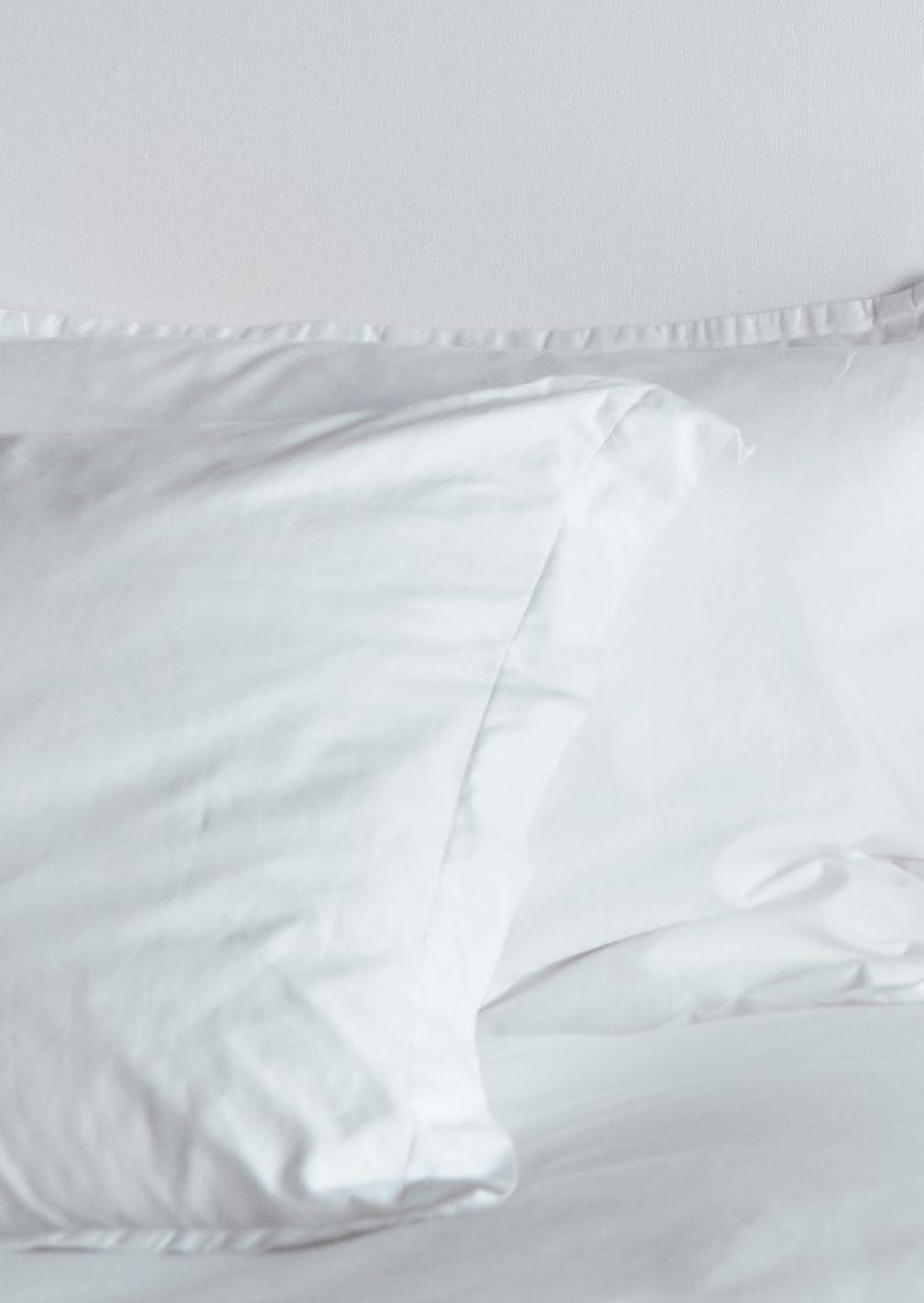
12 minute read
WHAT TYPE OF SLEEPER ARE YOU?
from HANRO Sleep Magazin 222_US
by HANRO
TO THE QUIZ
WHAT TYPE OF SLEEPER ARE YOU? ?Discover nightwear that meets all your sleep needs. Take our sleep quiz today. www.hanro.com/artofsleep
Advertisement
Nothing beats a night of deep and peaceful sleep. But let's face it, we don't always get the rest we need or deserve. In the summer, the heat makes us toss and turn for hours, while in the winter, we often shiver in bed despite our thick blankets.
The solution? Nightwear made of natural materials that perfectly adapt to your own individual sleep needs and circumstances.

CHAT
Together with Christiane Braun, Head of Product Management and Design at HANRO, we'll explore the different types of sleepers and offer tips for making the most of your sleep.

Nightwear made from a blend of wool and TENCELTM Lyocell is incredibly innovative. These "smart" materials are both warming and breathable. Wool offers excellent heat retention by design. TENCELTM Lyocell fibers are extremely soft and wick moisture away from the skin.
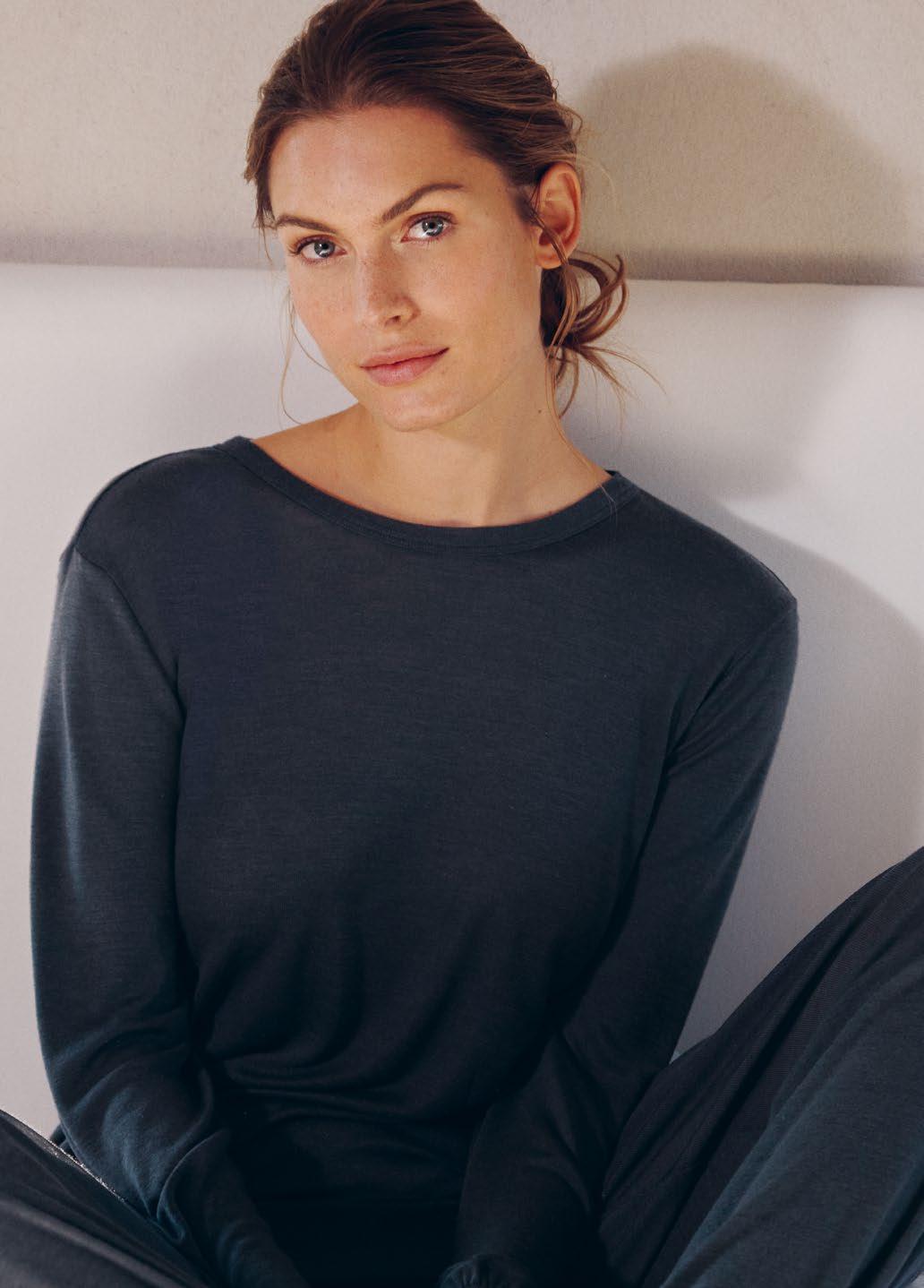
'Woolen Sleep' shirts and pants - a line for women and men, made of wool and TENCELTM Lyocell fibers MERINO WOOL
Our premium merino wool comes from South African farms that guarantee the welfare of their animals and refrain from using the controversial mulesing procedure. Merino wool is lightweight, odorless, insulating, and anti-static. It wicks away moisture, maintains its shape, rarely pills, and does not scratch.
thermal
Flannel is one of the oldest and most effective materials for cold temperatures. Pretreated, flannel does not lie directly on the skin. The material therefore always stays at a comfortable temperature. Cotton nightwear with a brushed interior also provides for outstanding sleeping comfort.

'Loungy Nights' pajamas done in 100% cotton flannel

SUSTAINABLE TENCEL™ FIBERS
TENCEL™ fibers are biodegradable and 100% compostable. They are breathable, soft as silk, and gentle on the skin.
Do you sweat while sleeping? If so, then opt for nightwear that quickly absorbs moisture. TENCELTM Lyocell fibers are known for keeping skin cool and dry.
Timeless and exquisite: 'Natural Comfort' pajamas by HANRO, made of cooling TENCELTM Lyocell fibers.
cooling
Less is more - if you're usually on the warm side, then lightweight, quick-drying cotton is for you. After all, cotton is highly absorbent.

'Juliet' lightweight cotton nightdress with spaghetti straps and pleats
COTTON
A renewable raw material, cotton regulates your temperature and wicks away moisture. It is also breathable, easy to care for, and highly absorbent. The quality of cotton is measured by the length and fineness of its fibers. The longer and finer the fibers, the higher the quality of the cotton fabric.

You‘re traditional and love to sleep in pure, basic cotton? This natural material is perfect yearround and feels wonderful on the skin. An expert in natural fibers, HANRO only uses high-quality cotton fibers, resulting in nightwear that is more durable, long-lasting, and sustainable.
Feminine embroidery highlights the minimalist look of this cotton nightwear. 'Zelda pajamas
cottonlove
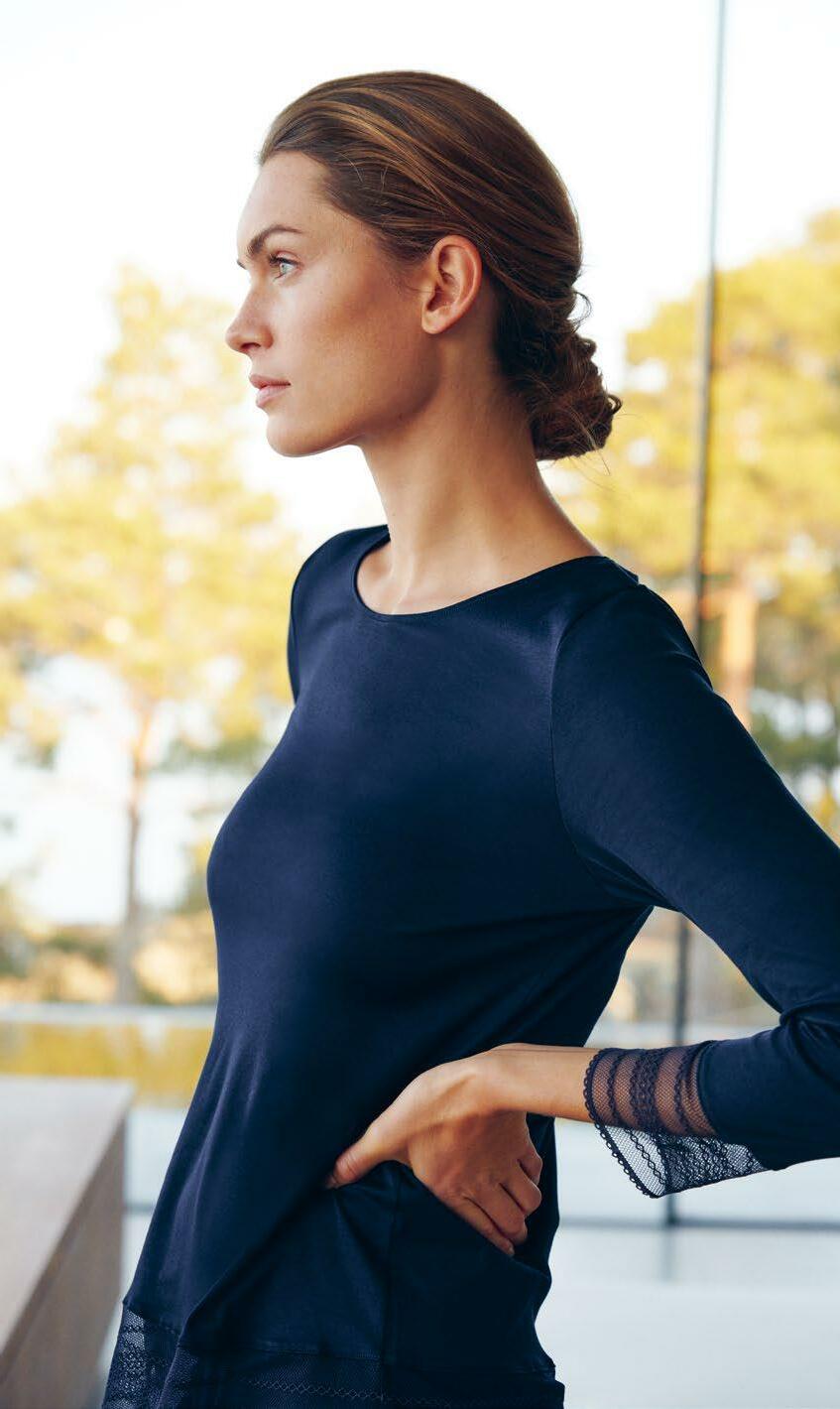
Turn heads day and night: HANRO 'Sina' cotton pajamas
You're a fan of sustainable luxury and have to have exclusive materials, even while sleeping? You can't go wrong with our nightwear made of modal, viscose, and silk. „I also love our blend of modal and silk, which is wonderfully lightweight, flexible, and breathable - and most importantly, sustainable“ says Christiane Braun.
Luxury nightwear: a short shirt dress that also looks great outdoors - our 'Grand Central' boyfriend nightdress
MODAL

Modal is derived from the natural raw material wood. Modal is considered more sustainable than cotton as less water and energy are required for its production and processing.
SILK
We source our silk from Europe and use mulberry silk, which is known for its outstanding quality and authenticity. Our products are made with completely degummed silk threads.
VISCOSE
Viscose combines the advantages of silk and cotton, all the while offering a soft, flowing, and comfortable feel. It is cool, gentle on the skin, and incredibly absorbent.
luxurious
A classy look that can be combined with a few accessories for an evening out.
'Grand Central' silk spaghetti top and pants
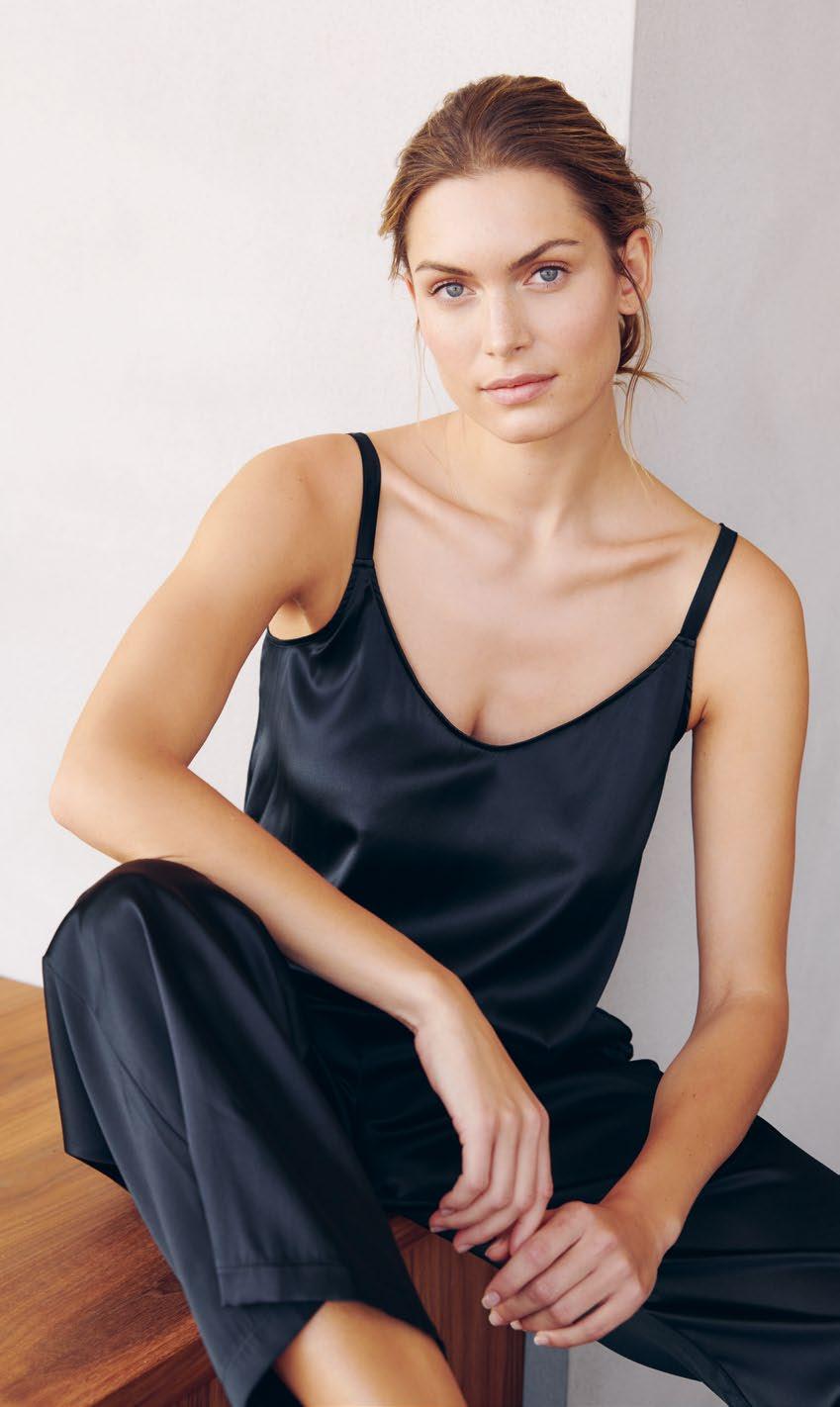

INTERVIEW
WE ALL SUFFER FROM CHRONIC SLEEP DEPRIVATION
INTERVIEW WITH PROF. GÜNTHER W. AMANN-JENNSON Sleep psychologist and the founder of Samina
A holistic view, sensitivity, reflection, and expertise: For more than 40 years, Prof. Günther W. Amann Jennson has approached the highly complex topic of sleep from a number of different levels. We sat down with the sleep psychologist to discover everything you need to know to have sweet dreams and enjoy better all-around sleep.
Hello Günther, how did you get involved with the topic of sleep?
I ran a psychological practice in Feldkirch in the 1980s. Within the first few years, I noticed that patients with mental, psychological, and health problems had one common denominator: poor sleep. This was my starting point in the world of sleep. 40 years ago, sleep problems weren't really an issue. Even today, sleep rarely gets the attention it deserves from the medical field – only lately have we seen things starting to change. Nevertheless, studies now show that 80 to 90% of all people have trouble sleeping.
You're considered a visionary in your field, and your multiple award-winning SAMINA concept gives credibility to your work. Which of your ideas have already materialized, and which are still driving you?
My initial goal was to find ways to help people improve their circadian rhythms. In simple terms, the idea was to significantly improve sleep. My second idea was a lot more imaginative. I wanted to provide therapy to people during their sleep. 40 years ago, people just shook their heads and asked, "How can you give therapy to a person who is asleep?" Today, at SAMINA, we offer a range of passive therapies. Incidentally, the right nightwear is also a type of passive treatment.
Because once we're asleep, we can no longer change anything. This is something people must understand. Sleep comes, but you need to prepare for it – or be perfectly equipped, so to speak.
You've already written a few books. Can you tell us a little bit about them?
My latest book, "Music Therapy During Sleep," explores a revolutionary idea: what do people need to move from a fitful to a peaceful state and thus improve the quality of their sleep? One of the best tools is music. Research on the effects of music studies the extent to which music improves our wellbeing, health, and sleep. Our online magazine simplyhealthysleep.com also covers all the interesting aspects of sleep, and the things that help with sleep problems and disorders.
What exactly happens to us while we sleep?
Everything changes when you sleep. Among other things, your heartbeat and
breathing slow down and your muscles become less tense. Your hormone levels also change. Sleep blocks us off from reality. The moment you fall asleep, you are more or less disconnected from the outside world. You are no longer conscious - at best, your subconscious and superconscious remain active. The second pertinent aspect of sleep is that it is reversible. No matter how deeply someone is sleeping, you can always wake them up.
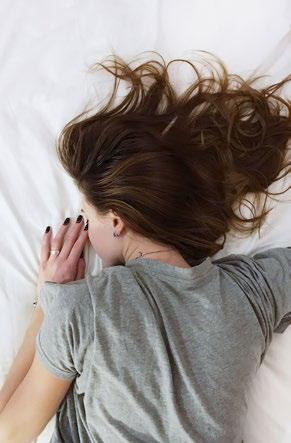
At night, we constantly toss and turn, regulating our body temperature without knowing it. The right nightdress or pajamas can help keep us at the ideal temperature.
such as biohackers who strive to measure and improve their body functions - are now "awake." These functions include sleep and heart rate variability, which is used to determine how well our bodies recover. An ECG is taken, which monitors the intervals between two heartbeats.
Why is sleep so important?
Sleep recharges us physically, mentally, and emotionally. It balances out the energy we expended throughout the day. Sleep is also vital to a properly functioning immune system. While in deep sleep, our brains rid themselves of harmful toxins which (among other things) can cause dementia. This is a highly complex process. In order for it to work, you must get enough sleep. The right nightwear is also a type of passive treatment. Because once we're asleep, we can no longer change anything. This is something people must understand. Sleep comes, but you need to prepare for it –or be perfectly equipped, so to speak.
New technologies allow for variability to be measured extremely accurately. The higher the variability, the better your body functions. These findings are helping to shine the spotlight on the importance of sleep.
Why do so many people have difficulty sleeping? A number of factors must
Why has sleep become such an important topic in recent years?
Simply put, because we are no longer able to sleep. Society has become more aware of the importance of sleep. Health-conscious people be reunited in order for you to sleep - and these factors have changed dramatically in the past 40 years. In today's world, getting a good night's sleep is a form of art. Sleep no longer comes automatically - you have to plan it. This is the only way to combat stress, or the biggest adversary of sleep. Stress releases hormones that make it difficult for people to fall asleep. Beyond a certain level, stress induces a "fight or flight" response that is impossible to ward off. We then find ourselves in a permanent
cycle of stress which not only has a negative impact on our health (cardiovascular, digestive, hormonal, and immune systems), but also -
and above all - on our sleep. We all suffer from chronic sleep deprivation.
How much sleep should we get per night?
The rule is quite simple: for every two hours awake, we need one hour of sleep. This is a law of nature. From a purely statistical point of view, people who get 7 to 8 hours of sleep per night are the healthiest and live the longest. In my opinion, this is the perfect amount of sleep. But we also need to think about the quality of sleep. It's no use sleeping 8 hours if it's the wrong kind of sleep.
How can I improve the quality of my sleep?
Sleep occurs in stages. There's the falling asleep stage, the light sleep stage, the deep
sleep stage, and the dream (REM) stage. Each stage is compared with the other to determine whether sleep is good or poor. I've been measuring sleep for more than 20 years and I rarely come across someone who sleeps really well. Our latest innovation is called the "SAMINA Sound Light Sleep System." It is a combination of music and colored light therapy. Music and light are the ideal mediums for controlling "fight or flight" responses. Fortunately, today we no longer have to fight or flee, but the response continues to be active - it's simply part of our biological makeups.
What contributes to healthy sleep?
Healthy sleep depends on a number of key factors. In particular, the conditions of your sleeping place (i.e., your bedroom) are of the utmost importance. Your sleeping place must be optimized if you wish to get a good night of sleep. Rule of thumb for better sleep: Go to bed at the same time, and get up at the same time. Ideally, your bedroom should also be quiet and dark. 90% of people have far too much light in their bedrooms at night, which may disrupt their sleep. In addition, your sleeping place should have plenty of fresh air (without pollution). We generate many air pollutants ourselves by keeping synthetic and chemical materials in our bedrooms. And finally, your bed itself plays the most important role in ensuring you get restful, restorative, and bioenergetic sleep.
What role does nightwear play in a good night's sleep?
Our body temperature changes during sleep. This is the main reason why we use nightwear (instead of sleeping naked). 70-80% of people today experience pain in their back, muscles, or joints. Sleep is vital for reinforcing these areas. In other words, for repairing joints, rebuilding muscle tissue, and eliminating things that we no longer need. In this way, sleep is the ultimate detoxifier. If you use nightwear made of a material that can absorb the half or whole liter of sweat that the body secretes overnight, then the conditions of your sleep are complete-
ly different. The "climate" of your bed is actually vital to the proper functioning of your body, including its detoxification process and the regeneration of its organs.
The closer something is to your body, the more it affects your sleep. Your underwear is your second skin, your nightwear is your third skin, and your bed is your fourth skin. Ideally, these layers will interact with each other.
Which materials do you recommend?
Natural fibers are best, as they "communicate" naturally with the body. In fact, the more natural the fibers, the more they resonate with our bodies. Another important factor when choosing materials is the ability to regulate body temperature and moisture. One of the primary functions of nightwear is to absorb moisture, or the film of moisture that forms on the skin.
creates a draft. The moment a layer of sweat forms on your skin, your body begins to cool down. Nightwear is of course designed for the night, when Our 'Woolen Sleep' line of nightwear your body temperature drops. swaddles you like a third skin. It can absorb up to 60% of its weight in moisture, When it's really hot, people and still keep you warm. think they don't need nightwear. However, the right fiber can help keep your body cool. Because once we're asleep, we can no longer change anything. This is something people need to understand - you have to prepare yourself for sleep.
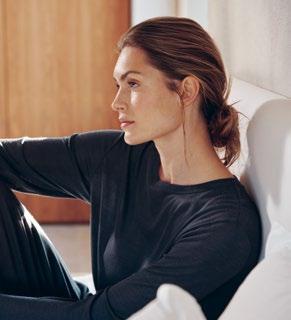
Thank you very much for this fascinating interview!
Read the entire interview here hanro.com/artofsleep
Sleeping naked is not a good idea on hot and humid nights as you've probably opened a window or set up a fan, which subsequently






